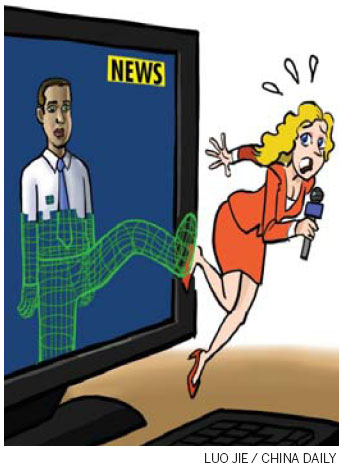Life and Leisure
New media bytes back with CGI
By Jules Quartly (China Daily)
Updated: 2010-09-17 07:49
 |
Large Medium Small |
I have the seen the future of news reporting and it's hilarious. It looks like computer-animated video and is streamed to your screen as an imagineering of a real event.

My current favorite takes a look at England soccer player Wayne Rooney's romps with prostitutes, and shows him kicking balls around hotel bedrooms before jumping onto a bed with two ladies of the night. The video also recreates Rooney's dalliance with grandmother Patricia Tierney, who walks with the help of a Zimmer frame, before taking out her teeth, putting them in a glass and readying herself to perform an act using just her gums.
My other favorite is a look at the war of words between the Wall Street Journal and New York Times, which has tycoon Rupert Murdoch swimming to the Big Apple with a shark fin on his back and ends with the line, "More and more New Yorkers are turning to the Internet for news rather than newspapers," while a computer screen shows: "The Daily Rehash, copy this, paste that."
If this sounds lighthearted, saucy and flexible with the facts, then you have an idea of the type of journalism we're talking about. It's tabloid, popular, and another media product from Jimmy Lai, who was born in Guangzhou in 1948. Soon after being smuggled to Hong Kong, aged 12, he started working his way up the food chain and bought into a garment factory before eventually founding Next Media.
The group's Next Magazine and Apple Daily were hits in Hong Kong and later Taiwan. He paid well, brought in journalistic talent and as news has migrated online has adapted to the times. His latest venture, NMA.TV is based in Taipei and produces animated accounts of real news events and are used in much the same way as photos used to brighten up a story.
While earlier versions of the animations were Chinese-language, the CGI (computer generated imagery) visualization of American golfer Tiger Woods' sensational meltdown made them international. It's own YouTube channel and exposure on social networking sites got NMA.TV further notice. Now it has its own website and blue-chip reporting organizations such as the BBC and Reuters have been buying English-language segments.
While NMA.TV doesn't pretend to be an oracle, it does intend to be a serious player and claims to put together all the news sources at its disposal to recreate an event quickly and accurately.
The point is that people like it and this should come as no surprise. We have increasingly turned to moving images for information as technology has evolved and reading has become fragmented, cut up into ever shorter articles until finally becoming the 140 words or less of Twitter.
Apple Daily was adding graphics to its news stories years ago and providing CIG for computer screens was the obvious next step. Some day, all news will be online and effectively cartoon animations will be accompanying them.
Critics may say this is terrible, a dumbing down, but they always do. My response is: it depends on how good, or bad, the animations are. If they serve a purpose they can be a lively and imaginative gateway to facts, or opinions, in a multimedia world.
